Dammed - stories from the LOWER SESAN 2
“I just can’t leave my culture behind. I can’t leave the dead bodies of my father and the other ancestors.” (Broch Rithy - activist and former villager of Kbal Romeas)
The controversial “Lower Sesan 2” is Cambodia’s largest hydropower dam.
Built by China's Hydrolancang in Stung Treng Province near the confluence of the Sesan and Srepok rivers, it began operations in 2018 with the aim to supply nearly 80% of the energy needs of the Cambodian capital Phnom Penh.
Once the gates of the dam were closed in 2017, an area of 34,000 hectares was inundated and some 2,700 households - mainly indigenous minorities Lao and Phnong - were forced to leave their ancestral land and sacred forest.
The monumental project not only altered the natural flow of the river and the fish circulation but it also disrupted the social structure of hundreds of indigenous families who lost their community livelihoods and cultural ties with their ancestral land.
I’ve had the chance to visit some of the communities affected by the construction of the “Lower Sesan 2” dam since 2015 and this is a collection of pictures I’ve captured during these trips.

Lower Sesan 2
August 18, 2016 - Stung Treng (Cambodia). A view of the vaste area that will be soon flooded when the construction of the Lower Sesan II dam will be finished. The 400-MW dam—a joint venture between Cambodian businessman Kith Meng and China’s Hydrolancang International Energy Co. Ltd.—displaced more than 5,000 villagers in Sesan district. Studies claim that the dam is seriously affect fisheries and the livelihoods of more than 100,000 residents living upstream and downstream of the dam. © Thomas Cristofoletti / Ruom
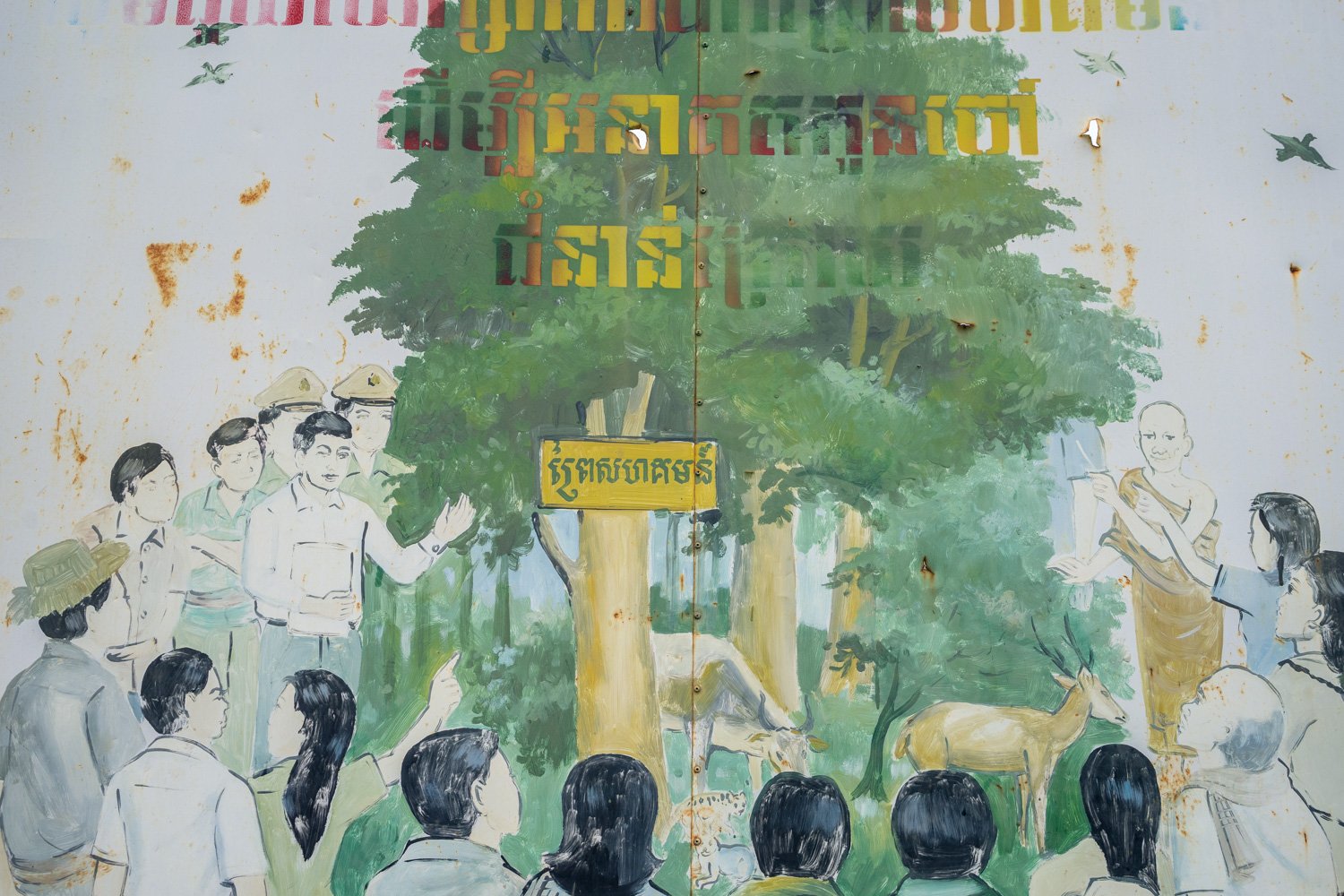
Lower Sesan 2
August 25, 2015 - Sre Kor village, Stung Treng (Cambodia). An old sign used to educate villagers to protect the environment is seen outside Sre Kor village. The village and the sorrounding areas have now been flooded with the closure of the gates of the Lower Sesan II dam. The 400-MW plant —a joint venture between Cambodian businessman Kith Meng and China’s Hydrolancang International Energy Co. Ltd.—displaced more than 5,000 villagers in Sesan district. Studies claim that the dam is seriously affect fisheries and the livelihoods of more than 100,000 residents living upstream and downstream of the dam. © Thomas Cristofoletti / Ruom

Lower Sesan 2
December 17, 2016 - Stung Treng (Cambodia). A truck carrying logs passes through a check point inside the construction site of the Lower Sesan 2 dam. A powerful conglomerate, headed by tycoon Kith Meng, chairman of Royal Group, received carte blanche by the goverment to fell and sell timber inside the 36,000-hectare reservoir reserved for the dam. But forest monitors allege that the construction of the dam led to large-scale deforestation of protected timber in the surrounding areas. © Thomas Cristofoletti / Ruom
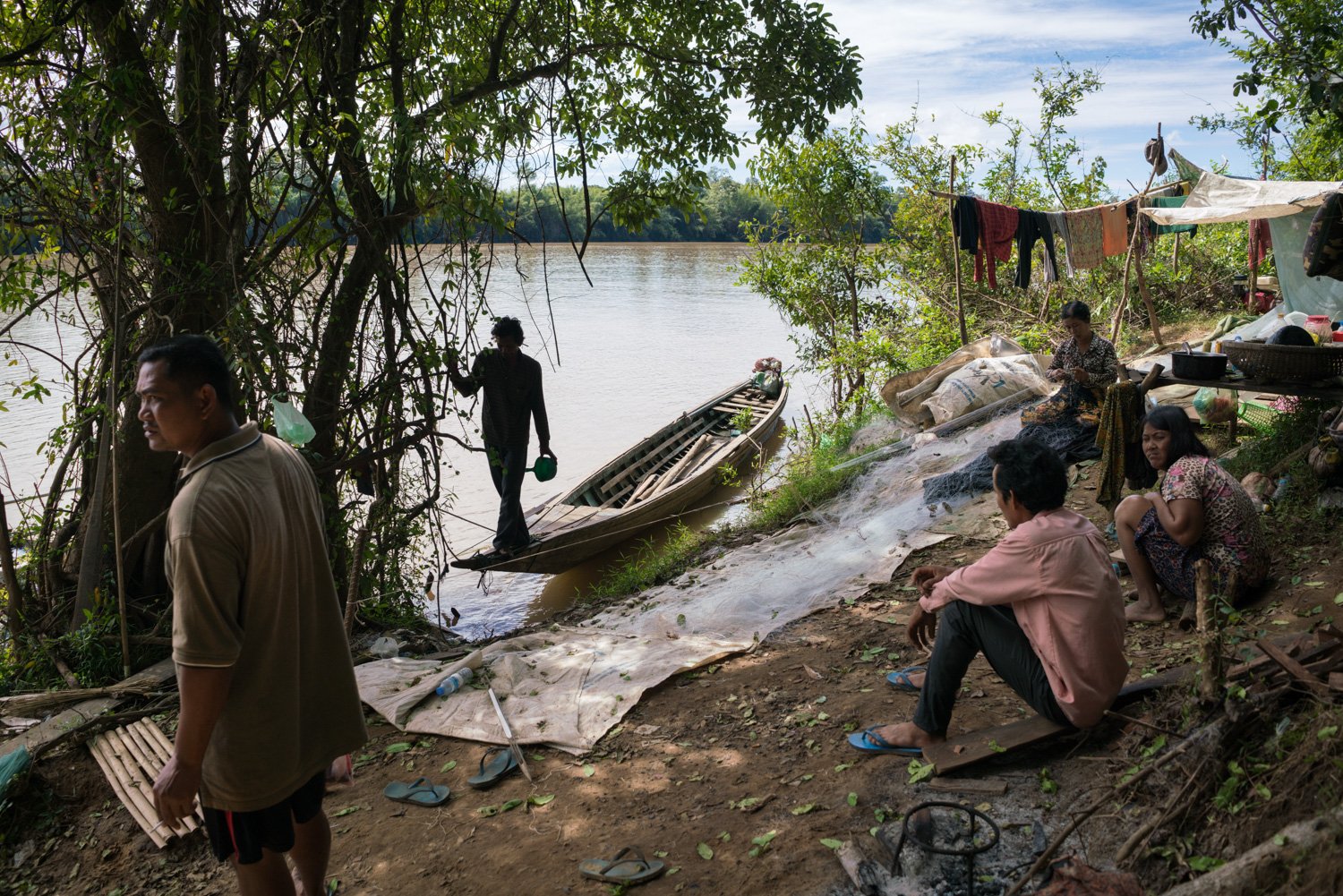
Lower Sesan 2
Dec 17, 2016 - Pluk Village, Cambodia. A group of fishermen and loggers in a temporary settlement along the Lower Sesan river. Forest monitors allege that the construction of the dam led to large-scale deforestation of protected timber in the surrounding areas. © Thomas Cristofoletti / Ruom

Lower Sesan 2
Aug. 17, 2016 - Kbal Romeas (Cambodia). Je Srey Neang (wearing a pink t-shirt) has lunch with her extended family in her small house in Kbal Romeas. For the previous couple of years she and her family fought hard the relocation’s plan. She was born in the village and she was worried of loosing their identity as indigenous once they will leave the ancestral land and forest. She now lives in a settlement built by a group of villagers who refused the relocation plan offered by the company and the goverment. © Thomas Cristofoletti / Ruom

Lower Sesan 2
Aug. 17, 2016 - Kbal Romeas (Cambodia). A spray sign 'No LS2 Dam' is seen on one of the house of Kbal Romeas. This is one of the villages that has been submerged by the water after the gates of the Lower Sesan 2 dam were closed in 2017. Thousands of families - mostly indigenous - living in Kbal Romeas and nearby villages were forced to relocate losing access to their ancestral lands and to the natural products that the forest and the river had provided them for generations. © Thomas Cristofoletti / Ruom

Lower Sesan 2
August 25, 2015 - Sre Kor village, Stung Treng (Cambodia). Locals transport pieces of wood with a tractor. A powerful conglomerate, headed by tycoon Kith Meng, chairman of Royal Group, received carte blanche by the goverment to fell and sell timber inside the 36,000-hectare reservoir reserved for the Lower Sesan 2 dam. But forest monitors allege that the construction of the dam led to large-scale deforestation of protected timber in the surrounding areas. © Thomas Cristofoletti / Ruom

Lower Sesan 2
Aug. 17, 2016 - Kbal Romeas (Cambodia). Monks have lunch at the Pagoda of Kbal Romeas. This is one of the villages that has been submerged by the water after the gates of the Lower Sesan 2 dam were closed in 2017. Thousands of families - mostly indigenous - living in Kbal Romeas and nearby villages were forced to relocate losing access to their ancestral lands and to the natural products that the forest and the river had provided them for generations. © Thomas Cristofoletti / Ruom© Thomas Cristofoletti / Ruom

Lower Sesan 2
Aug. 17, 2016 - Kbal Romeas (Cambodia). A wedding photo of Je Srey Neang and her husband in her small house in Kbal Romeas. The relocation cost the couple their marriage. Srey Neang fought hard against the relocation plan while her husband wanted to accept, leading them to divorce. © Thomas Cristofoletti / Ruom
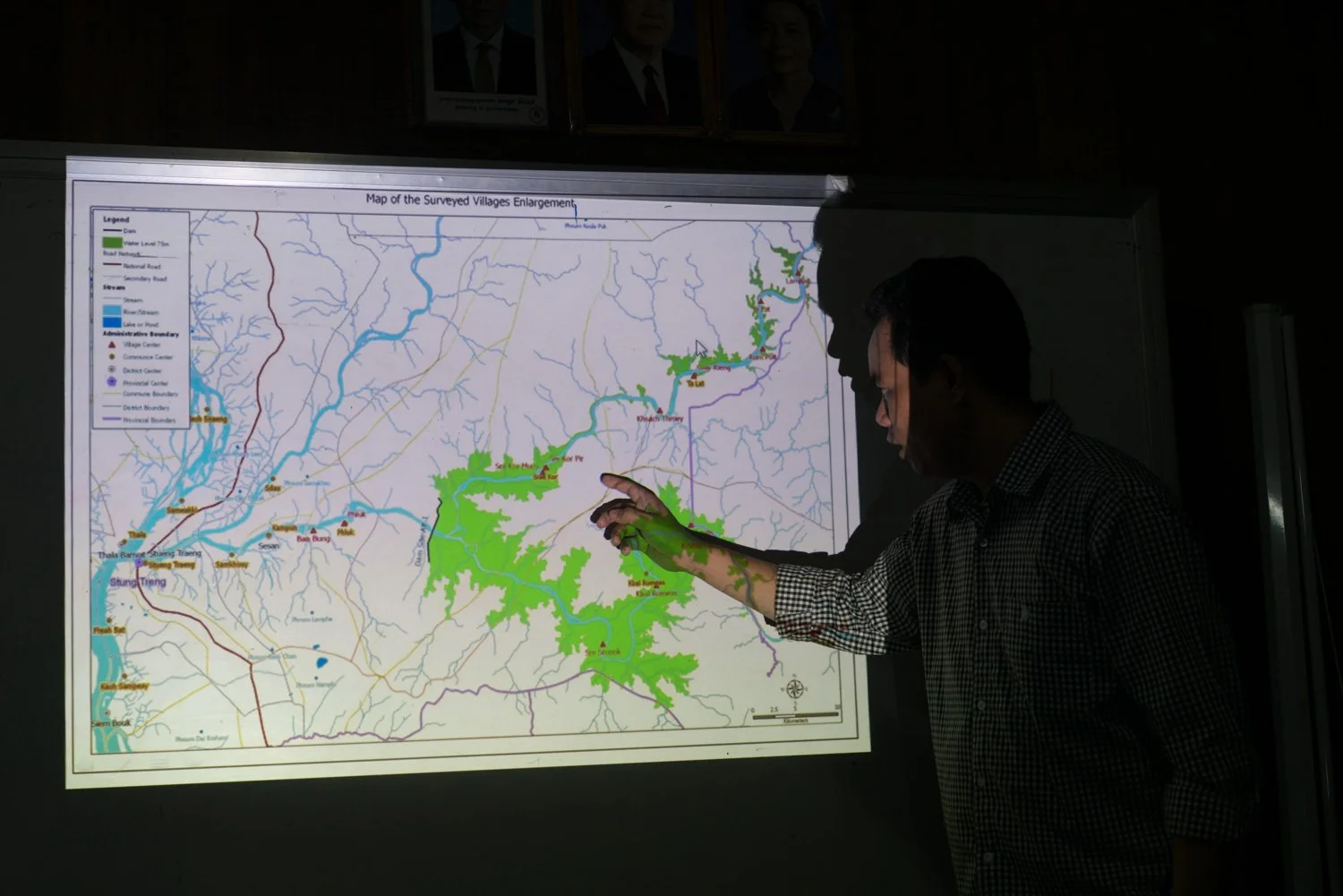
Lower Sesan 2
August 16, 2016 - Stung Treng (Cambodia). Ouch Vibol, an activist at CEBA (Cultural and Environment Preservation Association of Cambodia) shows a map with the areas - indicated in green - that will be flooded once the construction of the Lower Sesan II dam will be completed. © Thomas Cristofoletti / Ruom

Lower Sesan 2
March 06, 2020 - Stung Treng (Cambodia). Aerial view at sunrise of the controversial 400-megawatt Lower Sesan II Dam built in northern Cambodia. The dam produces most of the energy during the day affecting the level of the water of the Sesan river downstream during the night when the gates are closed. © Thomas Cristofoletti / Ruom

Lower Sesan 2
March 07, 2020 - Stung Treng (Cambodia). Aerial view of what remain of the forest that once surrounded the Lower Sesan 2’s reservoir. Forest monitors allege that the construction of the dam led to large-scale deforestation of protected timber in the surrounding areas. © Thomas Cristofoletti / Ruom

Lower Sesan 2
August 19, 2016 - Stung Treng (Cambodia). Aerial view of the one of relocation sites built by authorities for people that were living in the Lower Sesan 2 Dam reservoir area. The 400-MW dam—a joint venture between Cambodian businessman Kith Meng and China’s Hydrolancang International Energy Co. Ltd.— displaced more than 5,000 villagers in Sesan district. Studies claim that the dam could seriously affect fisheries, and put at risk the livelihoods of more than 100,000 residents living upstream and downstream of the dam. © Thomas Cristofoletti / Ruom

Lower Sesan 2
March 10, 2020 - Kbal Romeas II (Cambodia). Bai Yoeun washes his hands with the water from a well built in the relocation site for the people who were living in Kbal Romeas. Villagers complain that the quality of the water is not good enough for drinking and they use it just for washing and watering plants. © Thomas Cristofoletti / Ruom

Lower Sesan 2
December 16, 2016 - Sre Kor II Village, Cambodia. Thom Ne's husband sits with one of his children. He recently suffered a stroke and he's slowly recovering. The family was relocated from her village in Sre Kor to make way for the Lower Sesan II dam. They currently have no income in her new location and they already spent all the 6000 USD they received as compensation to move and renovate their house. © Thomas Cristofoletti / Ruom

Lower Sesan 2
March 05, 2020 - Stung Treng (Cambodia). Sothea fishes in front of the gates of the Lower Sesan 2 dam. Since the dam has blocked the river, he noticed less and less fish and it’s difficult for him and the other fishermen to catch anything. On a good day, he can catch around 10kg of fish and sell to a middle man for around 17 USD. © Thomas Cristofoletti / Ruom

Lower Sesan 2
April 24, 2018 - Stung Treng (Cambodia). A solar powered light illuminates Sreui Lang (19) and her small baby in the house they rebuilt a couple of km from their ancestral village Kbal Romeas, now flooded after the gates of the Lower Sesan 2 dam were closed in October 2017. Sreui Lang belongs to one of the 58 Phnong indigenous families who decided not to leave their village and continue fighting to preserve their way of life and identity. Struggling to find clean water and surrounded by large-scale industrial plantations the families resettled to an elevated area, a couple of km away from their ancestral village. © Thomas Cristofoletti / Ruom

Lower Sesan 2
July 19, 2018 - Phnom Penh (Cambodia). A single window has seen lit in newly built condominium in central Phnom Penh. In the last years, Cambodia’s real estate sector has seen a boom in high-end investment especially by Chinese buyers and has stoked concerns that they are pumping up a market in a country where the median household income is only around $11,000 per year. Half of the buyers are Chinese and most of the purchases are made for investment purposes by people who neither live in Cambodia nor rent the units. © Thomas Cristofoletti / Ruom

Lower Sesan 2
Dec 18, 2016 - Kratie, Cambodia. Workers connect lines for new electrify towers in Cambodia. Cambodia’s power grid has been largely dependent on electricity imports from neighbouring countries since 1993, with the country having to import 1,691 megawatts from Vietnam, 579 megawatts from Thailand and 10.73 megawatts from Laos in 2013. © Thomas Cristofoletti / Ruom

Lower Sesan 2
April 10, 2019 - Phnom Penh (Cambodia). A supermarket in Phnom Penh during a power cut. Due to the insufficient level of water to supply hydroelectric dams, Cambodia experienced an energy deficiency of 400MW and authorities were forced to repeatedly cut the energy supply to vast parts of the capital, drastically affecting small business owners and people who didn’t have access to generators or solar power. © Thomas Cristofoletti / Ruom

Lower Sesan 2
April 25, 2018 - Stung Treng (Cambodia). View of one of the classroom of Kbal Romeas’ school, now flooded after the gates of the Lower Sesan 2 dam were finally closed in October 2017. Thousands of indigenous Phnong families have been forced to relocate in the process. A 2009 report, released by the NGO Rivers Coalition in Cambodia (3 years before the project was formally approved by the Cambodian government), stated that more than 38,000 inhabitants of 86 villages “would lose access to the vast majority of their fisheries resources” were the dam to be built, while 78,000 people would lose some access to fish. © Thomas Cristofoletti / Ruom
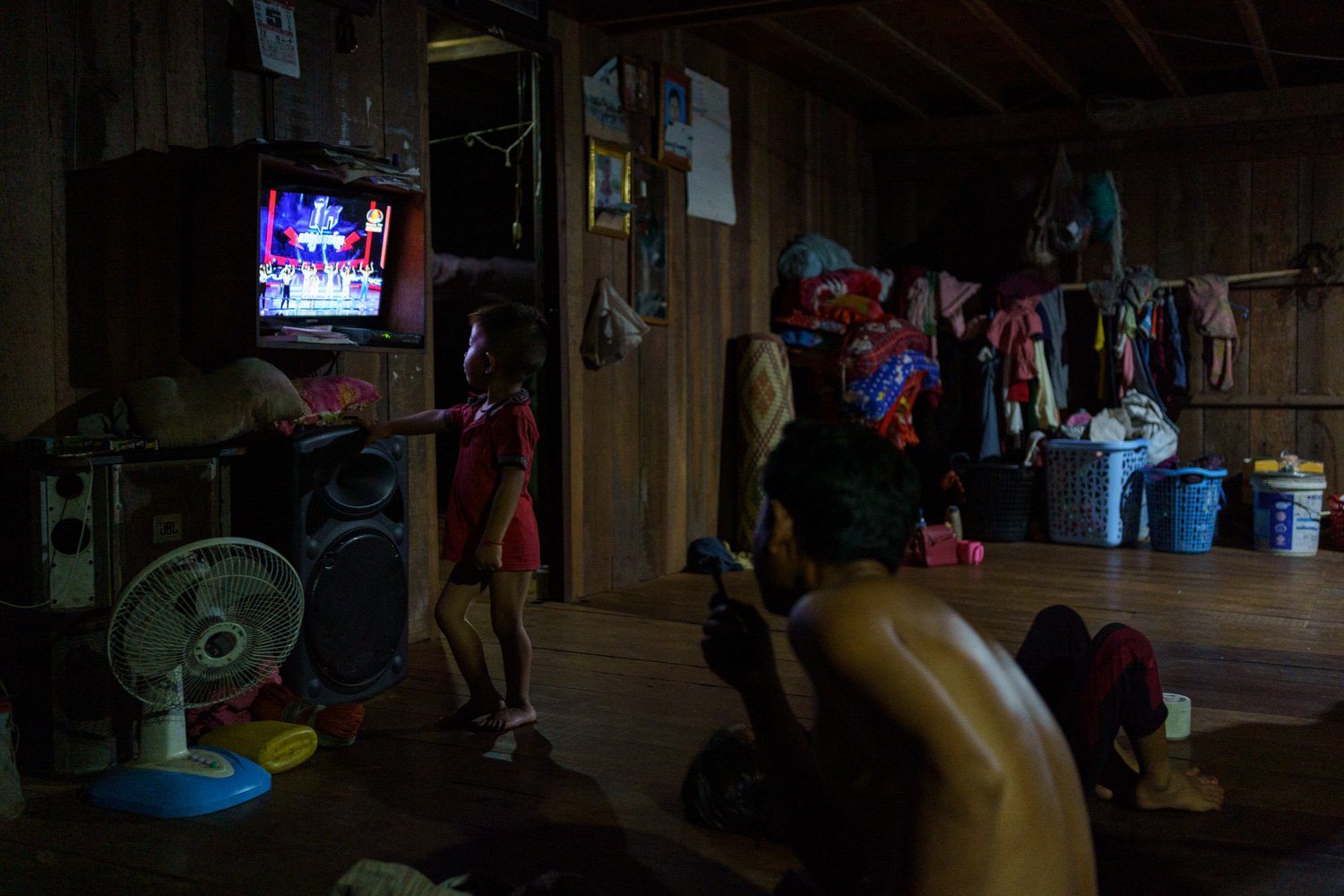
Lower Sesan 2
March 07, 2020 - Stung Treng (Cambodia). Activist and former Sre Kor’s inhabitant Sokhourn and his little son watch TV in their new house. His village was completely submerged when the gates of the Lower Sesan 2 dam were closed in 2017. Thousands of families - mostly indigenous - living in Sre Kor and nearby villages were forced to relocate losing access to their ancestral lands and to the natural products that the forest and the river had provided them for generations. Sokhourn, together with other families, decided to not accept the terms of the relocation from the government and he settled in a new village built at the edge of the reservoir. © Thomas Cristofoletti / Ruom

Lower Sesan 2
April 27, 2018 - Stung Treng (Cambodia). A ferry's service now help connecting the 2 shores of the Lower Sesan 2 dam's reservoir transporting goods and people. With the closing of the dam’s gates, the villages of Kbal Romeas and nearby Sre Kor were flooded and a massive lake now covers what once were hectares of ancestral forests and rice fields and dozen of families of fishermen have moved from other Cambodian provinces to take advantage of the abundance of fish. © Thomas Cristofoletti / Ruom

Lower Sesan 2
April 27, 2018 - Stung Treng (Cambodia). Phnong villagers from the - now flooded - Kbal Romeas meet to discuss how to rebuild their new settlement. Kbal Romeas was submerged when the gates of the Lower Sesan 2 dam were closed in 2017. Thousands of families - mostly indigenous - living in Kbal Romeas and nearby villages were forced to relocate losing access to their ancestral lands and to the natural products that the forest and the river had provided them for generations. Some families decided to not accept the terms of the relocation from the government and they settled in a new village built at the edge of the dam’s reservoir. © Thomas Cristofoletti / Ruom

Lower Sesan 2
March 07, 2020 - Stung Treng (Cambodia). A group of villagers build a new house in Sre Kor Thmei, a new settlement created by a 73 families of former residents of the old Sre Kor who decided to not accept the relocation deal from the government. 73 families - mostly ethnic Lao - living in Sre Kor were forced to relocate losing access to their ancestral lands and to the natural products that the forest and the river had provided them for generations. © Thomas Cristofoletti / Ruom

Lower Sesan 2
April 27, 2018 - Stung Treng (Cambodia). Phnong villagers from the - now flooded - Kbal Romeas meet to discuss how to rebuild their new settlement. Kbal Romeas was submerged when the gates of the Lower Sesan 2 dam were closed in 2017. Thousands of families - mostly indigenous - living in Kbal Romeas and nearby villages were forced to relocate losing access to their ancestral lands and to the natural products that the forest and the river had provided them for generations. Some families decided to not accept the terms of the relocation from the government and they settled in a new village built at the edge of the dam’s reservoir. © Thomas Cristofoletti / Ruom

Lower Sesan 2
April 27, 2018 - Stung Treng (Cambodia). Elders held a ceremony for the spirits to celebrate the foundation of the new village of Kbal Romeas with a small shrine made of bamboo and offers of rice and drinks. © Thomas Cristofoletti / Ruom

Lower Sesan 2
March 07, 2020 - Stung Treng (Cambodia). Banners used during the protests against the relocation are seen used as a garden fence by activist and former Sre Kor’s inhabitant Pheng Khey. Her village was completely submerged when the gates of the Lower Sesan 2 dam were closed in 2017. Thousands of families - mostly indigenous - living in Sre Kor and nearby villages were forced to relocate losing access to their ancestral lands and to the natural products that the forest and the river had provided them for generations. Pheng Khey, together with other families, decided to not accept the terms of the relocation from the government and he settled in a new village built at the edge of the reservoir. © Thomas Cristofoletti / Ruom

Lower Sesan 2
March 07, 2020 - Stung Treng (Cambodia). Kharn and her son Vatha collect cashew nuts in their 2 hectares farms in a new settlement created by villagers from the old Sre Kor and who decided to not accept the relocation deal from the government. 73 families - mostly ethnic Lao - living in Sre Kor were forced to relocate losing access to their ancestral lands and to the natural products that the forest and the river had provided them for generations. © Thomas Cristofoletti / Ruom

Lower Sesan 2
November 13, 2020 - Stung Treng (Cambodia). Aerial view of the old Kabal Romeas, one of the villages that has been submerged by the water after the gates of the Lower Sesan 2 dam were closed in 2017. Thousands of families - mostly indigenous - living in Kbal Romeas and nearby villages were forced to relocate losing access to their ancestral lands and to the natural products that the forest and the river had provided them for generations. © Thomas Cristofoletti / Ruom

Lower Sesan 2
March 07, 2020 - Stung Treng (Cambodia). Activist and former Sre Kor’s inhabitant Sokhourn, shows the remaining of his house. The village was completely submerged when the gates of the Lower Sesan 2 dam were closed in 2017. Thousands of families - mostly indigenous - living in Sre Kor and nearby villages were forced to relocate losing access to their ancestral lands and to the natural products that the forest and the river had provided them for generations. Sokhourn, together with other families, decided to not accept the terms of the relocation from the government and he settled in a new village built at the edge of the reservoir. © Thomas Cristofoletti / Ruom

Lower Sesan 2
March 06, 2020 - Stung Treng (Cambodia). A man is seen loading water from the Lower Sesan 2 dam’s reservoir into a tank to sell it to the villagers of Sre Kor Thmei. During the dry season. villagers don’t have access to clean water and they’re forced to buy it from these sellers. Sre Kor Thmei is one of the new settlements for the villagers who were forced to relocated to make space for the Lower Sesan 2 dam. © Thomas Cristofoletti / Ruom

Lower Sesan 2
March 07, 2020 - Stung Treng (Cambodia). Villagers are seen crossing the Lower Sesan 2 dam’s reservoir on a ferry trying to reach Sre Kor Mouy - a new village built by the former residents of Sre Kor and who didn’t accept the terms of the relocation from the government. Sre Kor was completely submerged when the gates of the Lower Sesan 2 dam were closed in 2017. Thousands of families - mostly indigenous - living in Sre Kor and nearby villages were forced to relocate losing access to their ancestral lands and to the natural products that the forest and the river had provided them for generations. © Thomas Cristofoletti / Ruom

Lower Sesan 2
March 9, 2020 - Ksach Thmey, Stung Treng (Cambodia). A family prepares dinner in their house in Ksach Thmey. Located upstream from the dam, Lao and Khmer families from Ksach Thmey village lost 30 per cent of their farmlands to the reservoir, and their remaining land is now prone to flooding. No compensation was provided to them. © Thomas Cristofoletti / Ruom

Lower Sesan 2
March 06, 2020 - Stung Treng (Cambodia). Workers repair a section of the fish ladder built close to the Lower Sesan 2 dam. The system costed $1.5 million and was engineered to facilitate fish migration overcoming the barriers caused by the dam. However no independent study has been conducted gauging the LS2 dam’s impact on fisheries since 2012 and it’s not clear how effective the ladders are. © Thomas Cristofoletti / Ruom
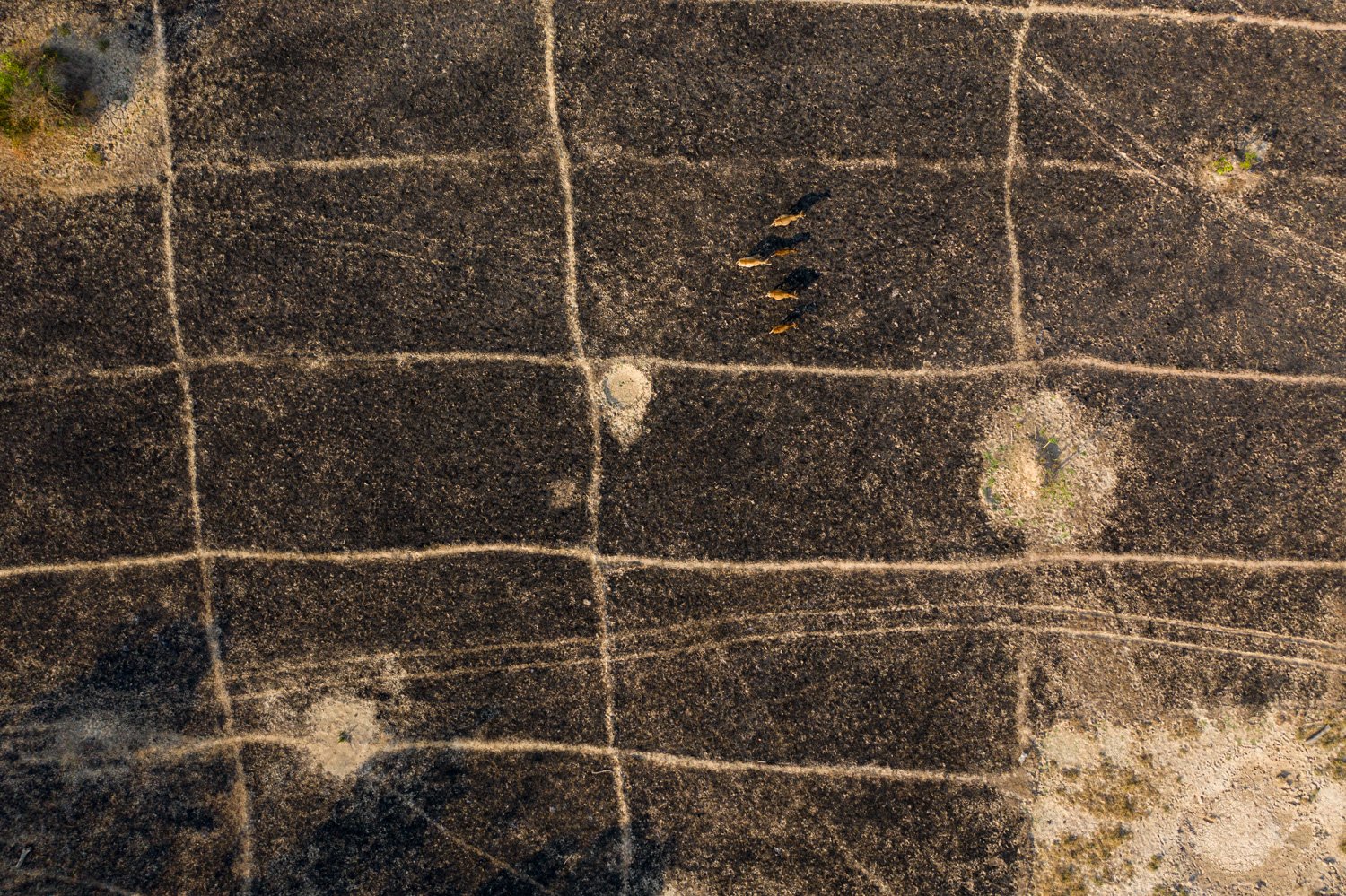
Lower Sesan 2
March 9, 2020 - Ksach Thmey, Stung Treng (Cambodia). Cattle roam across land that is now uncultivable due to periodic water infiltration and flooding. Located upstream from the dam, Lao and Khmer families from Ksach Thmey village lost 30 per cent of their farmlands to the reservoir, and their remaining land is now prone to flooding. No compensation was provided to them. © Thomas Cristofoletti / Ruom

Lower Sesan 2
November 13, 2020 - Stung Treng (Cambodia). Aerial view of the forest that surrounds the new settlement of Kbal Romeas and now partially flooded by the Lower Sesan 2 dam’s reservoir. © Thomas Cristofoletti / Ruom

Lower Sesan 2
March 06, 2020 - Stung Treng (Cambodia). A middleman buys fish from local fishermen in the stretch of the river in front of the gates of the Lower Sesan 2 dam. Fishing in area around the dam site is forbidden and fishermen can be fined up to 1.000.000 riel (250 USD). © Thomas Cristofoletti / Ruom

Lower Sesan 2
March 08, 2020 - Stung Treng (Cambodia). Aerial view of the old Sre Kor, one of the villages that has been submerged by the water once the gates of the Lower Sesan 2 dam were closed in 2017. Thousands of families - mostly indigenous - living in Sre Kor and nearby villages were forced to relocate losing access to their ancestral lands and to the natural products that the forest and the river had provided them for generations. © Thomas Cristofoletti / Ruom

Lower Sesan 2
April 25, 2018 - Stung Treng (Cambodia). Rithy (23) holds a snake that his cousin just caught in the forest. They will sell the meat in the local market for around 25 USD. The villagers were relying heavenly on the natural products they could find in the forest and the Sesan river. Forced to move their houses, they’re now struggling to find clean water and animals to hunt as the new village is surrounded by large-scale industrial plantations. © Thomas Cristofoletti / Ruom

Lower Sesan 2
March 10, 2020 - Stung Treng (Cambodia). Snails are collected in one of the Cham settlements built on the shores of the Lower Sesan 2 dam’s reservoir. When the dam gates closed, a fish boom occurred in the reservoir. Invasive species of fish and shellfish also began to appear. Ethnic Cham settlers from Kampong Cham Province, many of whom were landless or land-poor, moved in to take advantage of the fishery (depicted here), causing conflict with Bunong families from Kbal Romeas. © Thomas Cristofoletti / Ruom

Lower Sesan 2
April 24, 2018 - Stung Treng (Cambodia). Je Srey Neang in her new house with one of her daughter. The villagers were recently able to organize an impromptu school and a volunteer teacher is now giving classes to their children. © Thomas Cristofoletti / Ruom

Lower Sesan 2
March 10, 2020 - Stung Treng (Cambodia). Small fishes are collected to produce “Prahok” - a traditional Cambodian fermented fish paste - in one of the Cham settlements built on the shores of the Lower Sesan 2 dam’s reservoir. When the dam gates closed, a fish boom occurred in the reservoir. Invasive species of fish and shellfish also began to appear. Ethnic Cham settlers from Kampong Cham Province, many of whom were landless or land-poor, moved in to take advantage of the fishery (depicted here), causing conflict with Bunong families from Kbal Romeas. © Thomas Cristofoletti / Ruom

Lower Sesan 2
April 27, 2018 - Stung Treng (Cambodia). Fish vendors at the local market of Stung Treng, located where the Mekong and Sesan rivers join together. Fish experts have long warned about damage to fishing stock due of the construction of dams like the Don Sahong and Lower Sesan 2 on the Mekong river and its tributaries. © Thomas Cristofoletti / Ruom

Lower Sesan 2
January 05, 2018 - Phnom Penh (Cambodia). Locals enjoy an evening stroll at "Hun Sen Park" in central Phnom Penh. Behind them, the building of "Naga World 2" - the only casino licensed to operated in the Cambodian capital. Owned by the Malaysian multi-billioner Chen Lip Keong, the casino specifically targets Chinese clients. Cambodia has undergone rapid economic development in recent decades. However, the country still lacks the infrastructure required for the energy sector to match the pace of development, especially for the capital Phnom Penh, that alone consumes 90% of Cambodia’s electricity. © Thomas Cristofoletti / Ruom